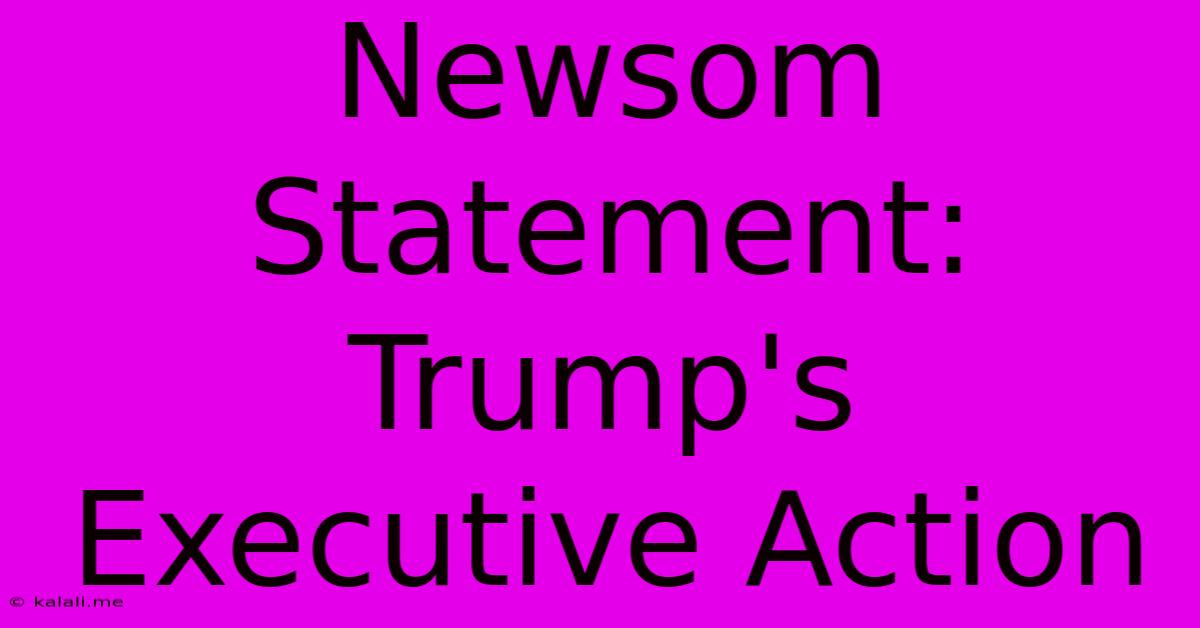Newsom Statement: Trump's Executive Action
Kalali
Jan 26, 2025 · 4 min read

Table of Contents
Newsom Statement: Trump's Executive Action – A Deep Dive into the Political Fallout
California Governor Gavin Newsom has consistently been a vocal critic of former President Donald Trump's policies. Newsom's statements regarding Trump's executive actions frequently sparked intense political debate and legal challenges. This article will delve into the key instances of Newsom's responses, analyzing their impact and the broader context of the political landscape they shaped. We'll examine the specific executive actions that drew the Governor's ire, the legal battles that ensued, and the lasting ramifications of this ongoing political feud.
Understanding the Context: Newsom vs. Trump – A History of Disagreement
The relationship between Newsom and Trump was marked by profound ideological differences and frequent public clashes. From immigration policies to environmental regulations, their disagreements spanned a wide range of issues. Trump's "America First" approach directly contradicted Newsom's progressive agenda, leading to numerous confrontations. This inherent conflict fueled Newsom's strong reactions to Trump's executive orders, often viewing them as detrimental to California's interests and values.
Key Areas of Conflict:
-
Immigration: Trump's strict immigration policies, including the "travel ban" and the increased border security measures, were consistently condemned by Newsom. He saw these policies as discriminatory and harmful to immigrant communities. His statements often highlighted the economic contributions of immigrants to California and the state's commitment to inclusivity.
-
Environmental Regulations: Trump's rollbacks of environmental regulations, particularly those concerning climate change, sparked fierce opposition from Newsom. California has been a leader in environmental protection, and Newsom viewed Trump's actions as a direct threat to the state's progress in combating climate change. He frequently emphasized the economic consequences of ignoring climate change and the importance of investing in renewable energy.
-
Healthcare: The attempts to repeal and replace the Affordable Care Act (ACA) under Trump's administration also drew strong criticism from Newsom. He defended the ACA and advocated for expanding access to healthcare, arguing that Trump's policies would harm millions of Americans, including many Californians.
Analyzing Specific Newsom Statements and Their Impact
Newsom’s responses to Trump’s executive actions weren't simply statements of disapproval; they were often strategic political maneuvers designed to galvanize support, challenge the legality of the orders, and solidify California's position as a counterbalance to the Trump administration. Let's explore some significant examples:
1. Response to the Travel Ban:
Newsom was among the first to publicly denounce Trump's travel ban, calling it discriminatory and unconstitutional. He used strong language, framing the ban as an attack on American values. His statements were widely covered by the media, transforming California into a symbol of resistance against the policy. This solidified his image as a strong progressive leader and attracted national attention.
2. Challenging Environmental Rollbacks:
Newsom consistently challenged Trump's rollbacks of environmental regulations through legal actions and public pronouncements. He positioned California as a leader in environmental protection, contrasting the state's actions with the federal government's approach. This strategy served both to protect California's environment and to enhance Newsom's image as a champion of environmental causes. His statements on this topic garnered significant media attention, particularly amongst environmentally conscious voters.
3. Defense of the Affordable Care Act:
Newsom's defense of the ACA mirrored his broader opposition to Trump's healthcare policies. He highlighted the potential negative consequences for Californians, utilizing emotional appeals to resonate with voters concerned about healthcare access. His strong stance on this issue helped solidify his base and attract support from voters who valued healthcare as a fundamental right.
The Legal Battles and Their Outcomes
Many of Newsom's criticisms of Trump's executive actions weren't limited to public statements. California actively engaged in legal challenges against various executive orders, often leading the charge amongst other states. These legal battles often involved complex constitutional arguments and highlighted the tension between federal and state authority. While the outcomes varied, the legal challenges themselves served as a powerful demonstration of Newsom's commitment to opposing Trump's agenda.
Long-Term Implications and Political Ramifications
Newsom's outspoken opposition to Trump's executive actions had long-term political ramifications. It strengthened his image as a progressive leader, enhancing his national profile and potentially contributing to his future political ambitions. Furthermore, it solidified California's position as a progressive stronghold, influencing national political discourse and policy debates.
The Newsom-Trump conflict serves as a case study in the evolving relationship between the federal government and individual states, particularly during periods of significant political polarization. It demonstrates how a state governor can use public statements and legal actions to challenge federal policies and shape the national conversation.
Conclusion: A Legacy of Resistance
Governor Newsom's statements regarding Trump's executive actions are a significant chapter in modern American politics. His consistent and vocal opposition helped define California's response to the Trump presidency, solidified his image as a key figure in the resistance, and contributed to a larger national conversation about federalism, executive power, and the future of progressive politics in the United States. The legacy of this ongoing political battle continues to shape the national discourse and influence policy debates today. The analysis of these statements and their impact provides valuable insights into the dynamics of American politics in a time of heightened polarization.
Latest Posts
Latest Posts
-
Where Is Food Coloring In The Grocery Store
Jul 06, 2025
-
How Do You Say Pickles In Spanish
Jul 06, 2025
-
How Much Is 1000 Hours In Days
Jul 06, 2025
-
Sic A Parrot On The Guild Emissary
Jul 06, 2025
-
How Many Slices Of Turkey Is 3 Oz
Jul 06, 2025
Related Post
Thank you for visiting our website which covers about Newsom Statement: Trump's Executive Action . We hope the information provided has been useful to you. Feel free to contact us if you have any questions or need further assistance. See you next time and don't miss to bookmark.